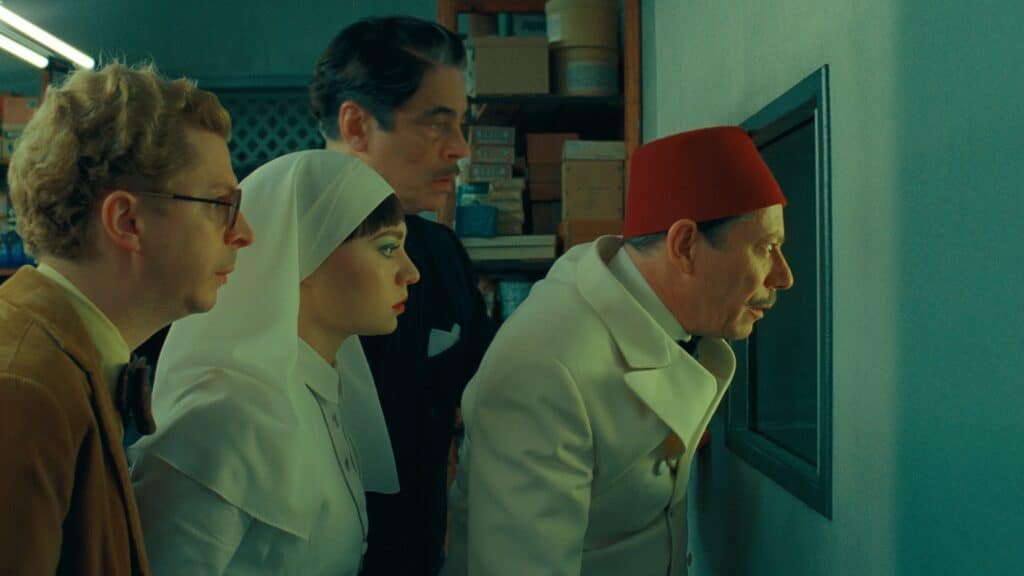‘The Phoenician Scheme’ Review
Benicio del Toro plays a cutesy war profiteer attempting his biggest project yet in ‘The Phoenician Scheme’, a very Wes Anderson movie.
With ‘The Phoenician Scheme’, Wes Anderson continues his recent run of foregoing genuine human emotion in favor of playing in bigger and prettier dollhouses. The craft on display, and the art direction throughout, are never less than stunning, and yet the resulting film feels empty, recycling themes and performers from his better films.
‘The Phoenician Scheme’ follows Zsa Zsa Korda (Benicio del Toro), a business man and war profiteer who has made enemies throughout the world for his self serving business tactics and immorality, threatening to cripple world economies in his own self interest. His latest project, the titular Phoenician Scheme, is a multipurpose infrastructure project to revitalize a desolate region in what seems to be an approximation of the Middle East. The film follows him and his pious daughter, Sister Liesl (Mia Threapleton), as they travel across the region to solidify support and financial backing from all of the necessary parties, all while governments do their best to sabotage the scheme and assassinate Zsa Zsa before he can achieve his goals.
The Phoenician Scheme, as an infrastructure project, and the entire region it serves is too vague to feel meaningful. Ultimately, it’s just a MacGuffin to serve as an overarching conflict, while ‘the gap’ that Zsa Zsa seeks to mitigate is a MacGuffin within that MacGuffin. None of it really matters, it’s just an engine to get the main characters traveling throughout the world, meeting the other cartoon characters standard in a Wes Anderson film. This plot is really just the backdrop for the main emotional journey of the film, that of Zsa Zsa and his daughter Liesl trying to understand each other, and find out whether each of them can find room for the other in their respective lives. If there is a recurring theme throughout Wes Anderson’s oeuvre, it’s the estranged relationships between parents and their children, and how childhood neglect and trauma ripples throughout a person’s life, even as families try to mature, connect, and find common ground. This theme has been handled more poignantly in Wes Anderson’s earlier films, and yet Anderson still proves adept at handling the delicacy of these relationships, providing the most emotional impact through Zsa Zsa and Liesl’s slow embrace of each other throughout the film.
As a protagonist in a Wes Anderson film, Zsa Zsa is an interesting choice. He is a war profiteer, who talks matter of factly about exploiting slave labor and bringing famine to wide swaths of the world. He feels discordant with the twee cuteness of a Wes Anderson film; there is nothing amusing or forgivable about his casual cruelty no matter how pretty the set design is, and yet in order for the film to work we need to align ourselves with his interests. This disconnect is just the beginning of why this film doesn’t succeed as much as Anderson’s best.

This film plays out almost like a parody of a Wes Anderson film, even as he continues to show mastery of camera movement, musical cues, blocking, framing and overall art direction. The visuals are consistently beautiful, including perhaps my favorite shot in Anderson’s entire filmography: the opening credits play against an overhead shot of Zsa Zsa in a bathtub, after one of many failed assassination attempts, being waited on by a team of nurses. The blocking of the nurses is elegant and surprising, particularly as one nurse brings in a bottle of wine for Zsa Zsa to open. Then when the title appears, the shot changes colors each time a word appears. It’s a beautiful opener, unmatched by anything in the remainder of the film.
Then the plot begins in earnest, and is repetitive to the point of exhaustion. As mentioned above, the actual scheme is too convoluted to have much vested interest in, but then each scene plays out in a predictable manner:
- Chapter title appears, mentioning who Zsa Zsa is going to meet with.
- Zsa Zsa and Liesl meet with the stated character.
- It is revealed that Zsa Zsa fiddled with the terms of their agreement.
- Shouting ensues.
- Something happens to keep these characters aligned with one another.
- Repeat until end credits roll
This isn’t a long movie, and yet each scene was so predictable that it felt much longer.
Then there are the characters. Wes Anderson has always had a distinct style of dialogue and performance, but usually the performers and characters are able to exhibit some humanity or distinction.
Not here. Each character reads the dialogue in a same-y deadpan voice, as if smiling or believing what you’re saying is illegal. They cannot emote or use five words when fifty will do. None of the actors are bad or miscast, per se, but they all feel interchangeable. In Wes Anderson’s tightly controlled world, the actors are just another piece of set direction. Humanity would just get in the way.
Ultimately, Wes Anderson delivers beautiful moments that other directors often feel incapable of. The art direction is incredible and there are laughs throughout, even as the characters are hollow and the plot is overcomplicated. If you are not a fan of Wes Anderson’s style, you will not like this movie. And if you are a fan … even you might be tired of the schtick by the end of this one.
The Phoenician Scheme
Rated PG-13 for violent content, bloody images, some sexual material, nude images, and smoking throughout.
Running Time: 1 hour and 45 minutes
Director Wes Anderson
Writers Wes Anderson, Roman Coppola
Stars Benicio del Toro, Mia Threapleton, Michael Cera, Riz Ahmed, Tom Hanks, Bryan Cranston, Mathieu Amalric, Richard Ayoade, Jeffrey Wright, Scarlet Johansson, Benedict Cumberbatch, Rupert Friend, Hope Davis
Rating PG-13
Running Time 105 Minutes
Genres Action, Comedy, Crime, Drama
